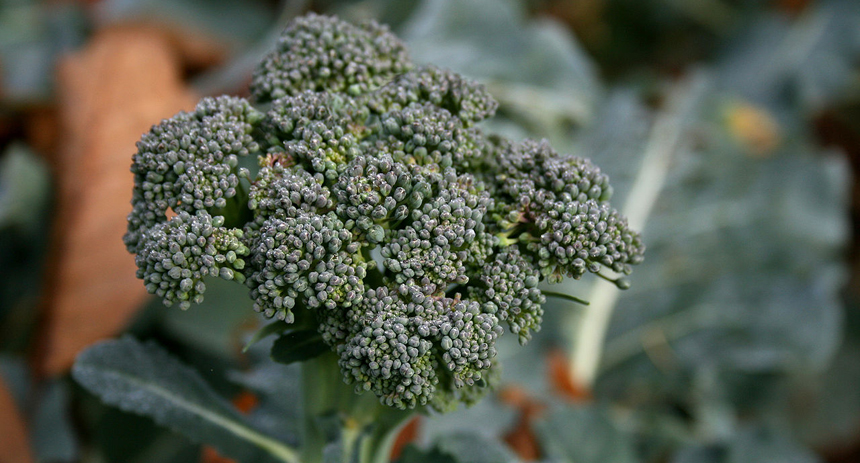Veggies: A radiation shield
Certain crunchy veggies in the broccoli family protect rats’ healthy cells from killer radiation

In the body, vegetables like broccoli and cauliflower produce a compound called DIM. A recent study shows that compound protects healthy rat cells from radiation.
KARELJ/WIKIMEDIA COMMONS
Radiation can help or harm — and sometimes do both at the same time. When used as a medical treatment, radiation kills cancer cells. But any nearby healthy cells hit by the radiation also will die or suffer lasting harm. Unless, that is, the body quickly repairs them.
Scientists have identified a chemical that might help with these repairs. It’s called DIM, and it develops in the body after eating a diet rich in broccoli and related vegetables, such as cauliflower, Brussels sprouts and kale.
Known as cruciferous (Kru SIF er us) veggies, each of these contains a healthful compound. In the stomach, that compound is converted into DIM (also known as 3,3’-diindolylmethane). Scientists have now shown that DIM helps cells recover from high doses of radiation, at least in rats. The good news: Only healthy cells benefit. Radiation still kills cancer cells, even when there’s plenty of DIM around.
Saijun Fan of Georgetown University in Washington, D.C., and his coworkers described their findings October 14 in the Proceedings of the National Academy of Sciences .Earlier studies in animals have showed that DIM can kill cancer cells. Those studies suggested DIM might work on people with cancer, too. (Stores sell DIM as a food supplement, but its health benefits in people are still being studied.)
In 2009, Fan and Eliot Rosen led a team at Georgetown that showed DIM’s benefits don’t stop with fighting cancer. DIM also protects cells from some types of chemical damage. Now they’ve extended their findings to DIM’s protection of cells hit by radiation.
The team focused on a type of radiation — gamma rays — used to treat some cancer patients. The researchers beamed high doses of this radiation at healthy rats. Within 10 days, all of the animals died. The outcome was different, however, when rats received a hefty dose of DIM after radiation exposure.
Two hours after zapping a group of rats with gamma rays, scientists injected the animals with DIM. Those rats continued to get a dose of DIM each day for two weeks. A month after the radiation exposure, six of every 10 of the DIM-treated rats was alive. And these survivors were still alive two months after that.
A different group of rats also got DIM. Their two weeks of injections, however, started 24 hours after being zapped. Among these rats, only half as many survived the tests: just three in every 10.
Scientists have known for decades that the body has ways to repair radiation damage. The new data suggest DIM gives that repair system a boost. And the new experiments indicate DIM works quickly.
More importantly, DIM shows promise for people with cancer. The scientists exposed rats with the disease to radiation, then gave them DIM. The treatment protected healthy cells, but not cancerous ones.
Protecting those healthy cells is important. Damage to them causes horrible side effects in cancer patients treated with radiation.
Biologist Gary Firestone of the University of California, Berkeley, has studied the benefits of DIM and similar compounds for decades. He says DIM has the potential to minimize side effects of radiation treatment for cancer patients. Indeed, the next step in DIM research is “to see whether it works in humans,” he told Science News.
DIM treatment might one day also find use well outside of medicine. It might be used to treat healthy people exposed to potentially lethal amounts of radiation. For instance, if a nuclear bomb went off or a nuclear reactor broke down, DIM might help people naturally repair damage to any cells not killed outright by the radiation.
So, if you’ve been arguing for years that being served broccoli or kale at dinner is like being asked to eat medicine, you may be right. And you can thank the cook for protecting those cells of yours.
Power Words
cancer The rapid, uncontrolled growth of abnormal cells. It can lead to tumors, pain and death.
cell The smallest structural and functional unit of an organism. It is typically too small to see with the naked eye.
radiation Energy, emitted by a source, that travels through space in waves or as moving subatomic particles. Examples include visible light, infrared energy and microwaves.
nuclear Powered by the energy released in nuclear fission or fusion.







